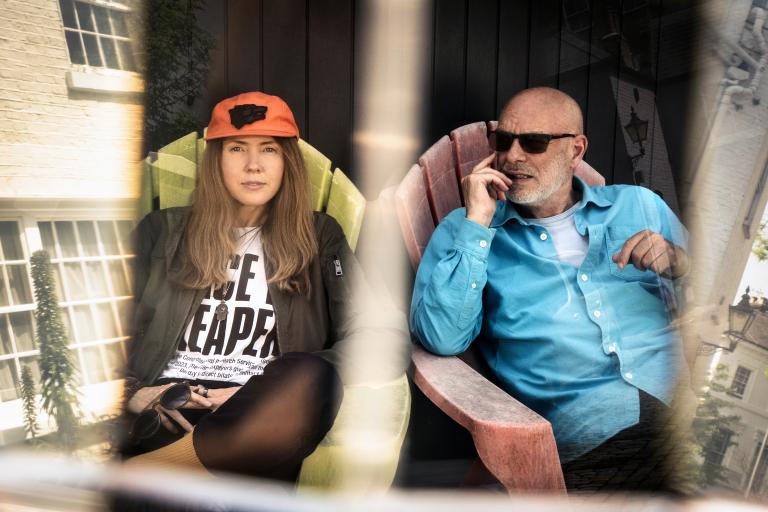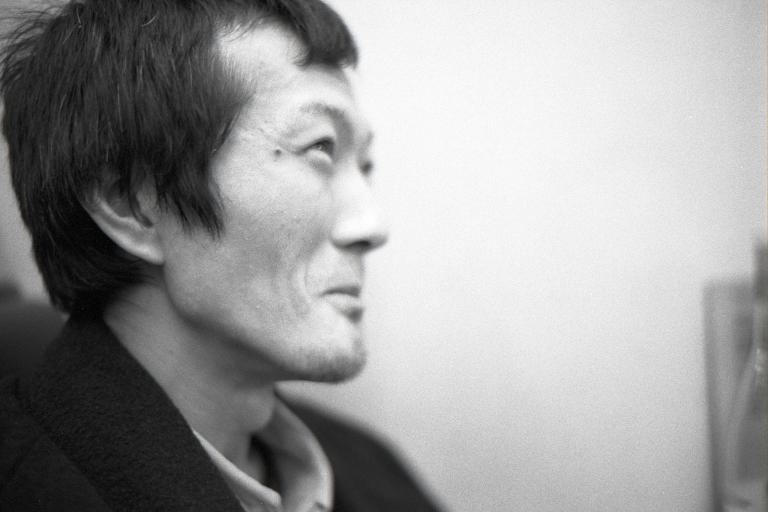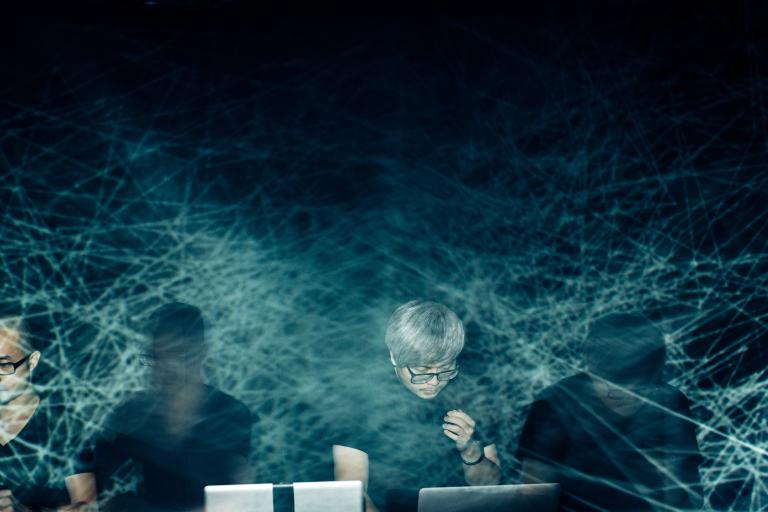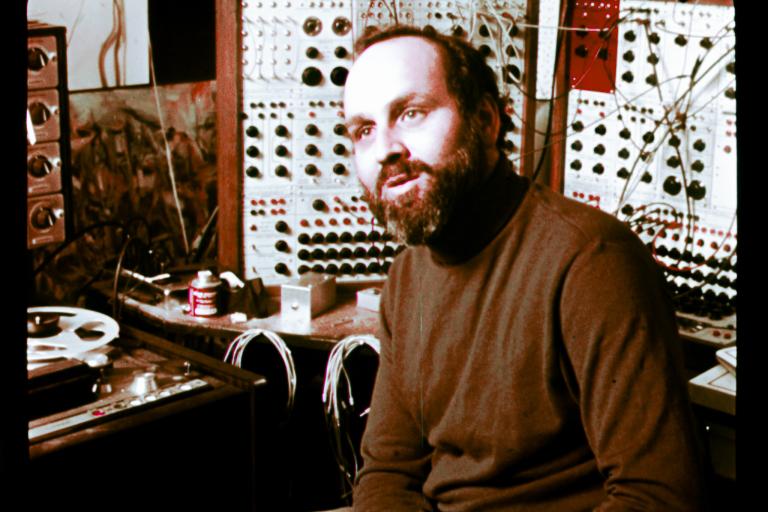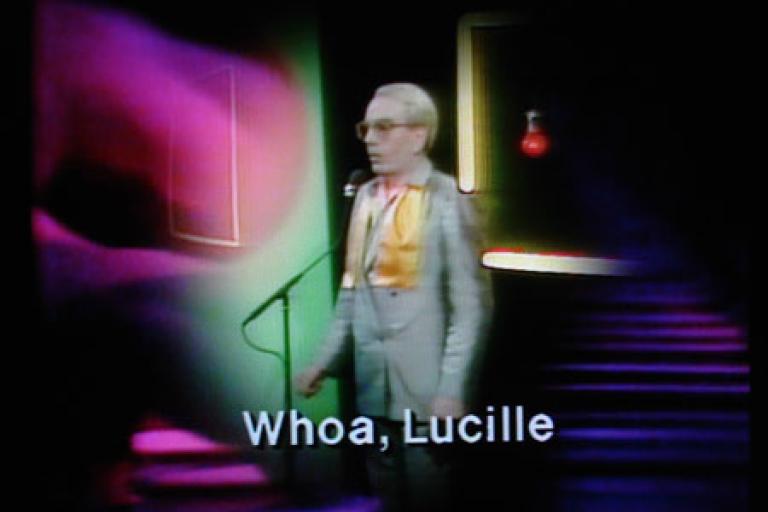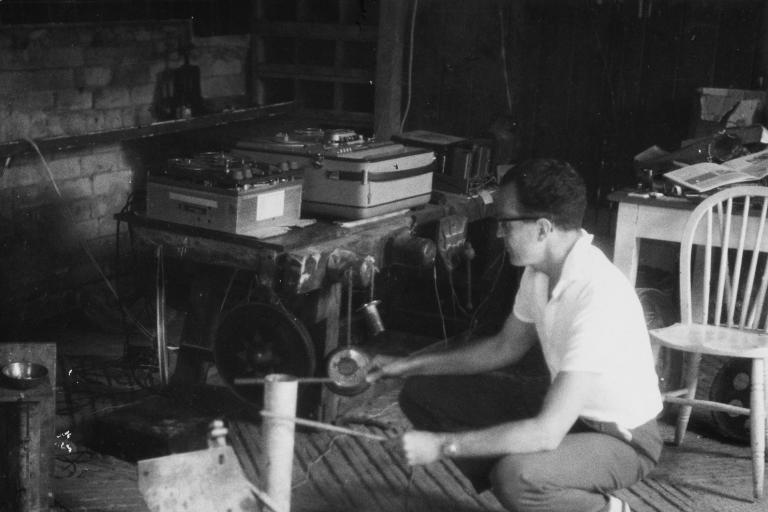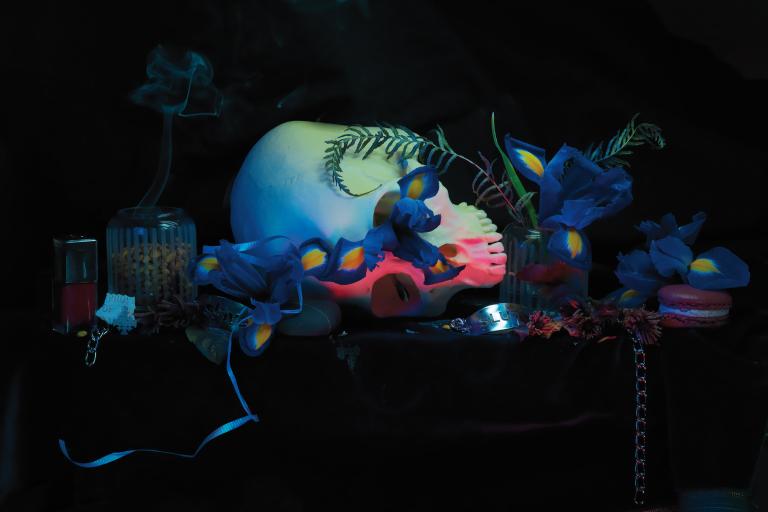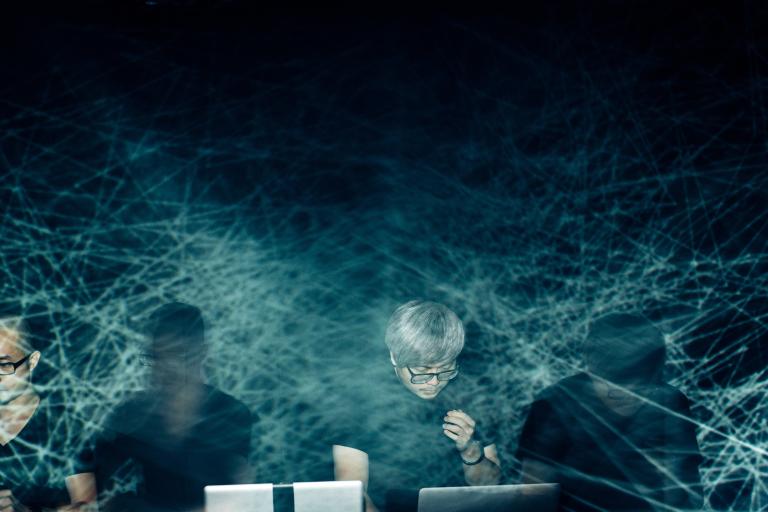In the background are the vapid yips of a dog, air blowing out of a mouth, plastic and metal clinks, agitated murmuring, then insects, the sonic debris of Guryong, a contested urban slum across the highway from Seoul’s wealthy Gangnam District. An elderly Guryong resident recounts in Korean her life in the makeshift village, but her voice becomes spliced into melodic loops of diphthongs and fragmented syllables. “How can I explain this?” Italian composer and sound artist Alessandro Bosetti asks at one point against the mesh. “At first, I have written this text, which says your voice is trash. It’s trash I love. It’s trash I care for.” One moment finds excerpts about Guryong’s politics; the next, garbled noise, translated scraps of a fraught narrative, then autobiographical ruminations of Bosetti’s relationship with his partner, slowly coming apart. In Bosetti’s “Guryong –– Voice as Trash”, affective textures dovetail –– from decay and love to regret and curiosity, disruption, and melody, always with a forward motion. “Walking through Guryong now, around me, there’s nothing of what was there at the time. It’s dark, and I’m just remembering.”
Awarded Euroradio’s Palma Ars Acustica in 2015, Bosetti’s longtime fascination with sonic materiality and abstraction has yielded a diverse oeuvre of nonlinear sound art. Thematically, his work is underwritten by a commitment to making useful pieces of political, emotional, sonic refuse and a desire to animate life in uncommon objects. His performance and lecture “Plane/Talea” centers on a sprawling sonic mass, understood as a “sound creature”, assembled from thousands of abstracted sound particles and atomized vocal samples. “Journal de Bord” features Bosetti performing a lyrical, spoken-song re-enactment of one of his mother’s journals, written on a 1978 sailing trip to the Canary Islands. One afternoon, Bosetti and I sat down to talk about, among other things, the value of trash and the utopic possibilities of the choir.
Andrew Tan-Delli Cicchi: What provoked your interest in sound as an artistic medium?
Alessandro Bosetti: I guess it was a sensibility I’ve always had. From early on, I had a sensitivity towards timbre. My way into music was through orchestration, as a synonym for noise. The first thing I felt about music was wondering what instrument was playing, rather than the rhythm, harmony, or melody. Later on, it was that interest in timbre and noise that pointed towards speech, or the use of voice or language inside a sonorous domain, which is less pixelated in a way, in terms of the grain of the sounds of speech. It’s very mysterious how different voices have such different sounds. If you listen to classical singing techniques, it seems that singing schools try to even out voices into specific aesthetics. When you listen to regular people talking, there’s a huge variety.
There’s always been this interest in the instrument’s sound. I used to play soprano saxophone. I distinctly remember being a child and hearing a soundtrack of cartoons. It was “Miles on the Corner” or some imitation of Miles Davis — something with the texture of a Fender Rhodes, the wah-wah on the trumpet, a lot of cymbals in the drumming, and soprano saxophone. I was fascinated by it, and I picked up on how this sound emerges in different contexts. Then, when I was 12, one of the first pop concerts I saw was Sting and his band performing his solo work. He was playing with a jazz band, and they were playing these songs with Branford Marsalis on the soprano saxophone. I was singling out specific instruments… Then there came Steve Lacy and this full-on love with the sound of that instrument.
You note music concrète as something your art descends from. Your references span Sartre, Heraclitus, and others. Can you talk about this and the other artistic and theoretical influences that color your work?
Literature has been a powerful influence — especially Italian avant-garde experimental literature. Everything from the 50s to the 80s, from [Carlo Emilio] Gadda, [Giorgio] Manganelli, [Italo] Calvino. I related a lot to similar things happening elsewhere, like Oulipo; these things had a really strong impact on me.
The other thing was my encounter with the world of radio and radio art... Now it’s been almost 20 years, but discovering the field of radio art meant discovering a lot of things that didn’t conform to my idea of what music was. I had this idea of music that wasn’t very accepting, like when you have somebody speaking, and you need to put it into a certain construction which gives it a lot of conscious attention. Radio art had this ambiguity. Nobody can really tell how it sounds; nothing is prescribing that it should sound one way or another. The way I look at radio is from a very primitive perspective; it’s a device that transports sound from one place to another, taking sound and putting it somewhere else.
I began discovering this world of radio art, what you can do in this landscape, especially after moving to Germany in 2001 and hearing about the Hörspiel, Neue Hörspiel, and Ars Acustica traditions. All that was a huge influence — discovering that there is a freedom in this indeterminacy, in not knowing exactly what you’re supposed to do or how it’s supposed to sound so that you can reflect on the nature of the medium, which is very enigmatic and interesting. This was a great exit strategy for me to make music. Still, now I think I’m a composer disguised as a radio artist, just looking for a room with a certain freedom.
Theory came later, after literature. Recently I’ve been getting into theory, thinking more and more about what I do as connected to speculation on the nature of the subject. I’m trying to develop ideas on how the philosophy of the voice can be thought about as a philosophy of the subject, how voices can be treated as beings somehow. I started looking into many different theorists who see things from the subject's perspective, trying to find references and possible inspirations for a kind of work that involves disembodied voices.
I wanted to start with the choral composition “Plane/Talea”, and the radio show Regular Measures, which you describe as body-less sound creatures or friends. In “Plane/Talea”, there’s the automaton figure; at other points, the sound assemblages are described as friends or individuals. There’s this idea of the non-human subject in the way you speak about sound. How do you think of these sound-creatures and their human/non-human elements?
In a way, I think about that piece or series of pieces — that’s my way of thinking of it — as a practical meditation, a sound meditation on that question. That being said, I think it’s also fiction somehow, working through metaphors, because, of course, a recorded voice comes from a body, which has a gender, which has an age. My process is a process of abstraction; it’s trying to think of those voices as separate from their origin and their context and all the political, social, and biological implications that they may have. It’s a paradox, something that’s… naïve, maybe. But it’s the direction I’m trying to go in. Maybe I hope it’s not naïve, because if you can start thinking about those voices as having their own autonomy, by extension, this becomes true for not only the voices in my piece, but it can reflect on the status of all the voices that are encrusted in a lot of other sound art and radio art pieces.
There are a million examples, but, going back to a personal favorite, I’m thinking about the historical piece by Bob Ostertag called Sooner or Later, where he takes a short sample of the voice of a child burying his father, who has been killed during the oppressive war in El Salvador in the 1980s. You have this very short sample of this voice which is very charged. The sample itself is concise, but he developed it using the sampling techniques of the time, exploding the sound of that sample over a long composition. Of course, that voice refers to a specific person, a child, who is now an adult, in a specific political struggle and situation. But at the same time, the process of abstraction is so strong; you wonder if this voice is becoming a being. Is this voice alive on its own? You see this voice in the media, voices of people who are long dead. Those voices are alive, and they do things, and they exist as subjects in another kind of texture and reality. That’s what’s interesting to me.
Then there’s Huis Clos, the Sartre play of those three people in a room in the afterlife that you’ve mentioned as a strong influence. You describe them being alive on their own terms, and also the fact that if “they are not anymore present here with us, that does not mean that they are necessarily dead”. What does it mean for something to take on life?
I really wish I knew. I guess that’s a nice question for me. I think it’s something to do with emotions, affects. Any object that comes alive starts to interact with you in a way that has affection in it. You go to the supermarket, and you buy a bottle of tonic water and drink it and interact with it — but only as an object. But an art object, an idea that starts to pick up life, starts to move with you on an emotional level. Those objects feel things or make you feel things, and you don’t know if it’s you feeling it or if something else is happening.
I know it can sound very stupid or emotional in a sense. Like, of course, you’re projecting something onto it. But can we bring back this sort of idealistic discourse in another way that isn’t reactionary but can be serious, too? That it might have moved something in you — what if?
The relationality between you and these assemblages seems important, too. These sound-creatures, messy fusions, and transplants decaying are often referenced in intimate terms, such as friendship or polyphonic community. What types of interrelational possibilities do you think they express?
There is friction in my identity as an artist. There are a lot of relations in my work, and I engage with a lot of participants. Still, I’m not particularly relational as an artist; I like to retreat and be alone. That’s something much more 19th-century in my practice. At the same time, I like to think that, through this speculation and abstraction, there are ideas of possible interactions between humans and between humans, devices, and artifacts that can be thought of as different. That may come out of it, but I don’t know. Every time, there are instances of encounter and relation in pieces of mine, but I don’t have a recipe for how people should come together in a political sense.
You mentioned Regular Measures, which is very similar to “Plane/Talea”. Four guests come together in the dark, and they’ll be there together for an hour. We play recorded voice-sounds for them, and we pretend after a while that all these voices have no body. And for all those listening on the radio, they are not able to tell the difference between the samples and the participants’ voices.
Philosophically, I’m looking at those sets of voices-without-bodies as communities that are somehow universal. Trying to get away from the body — although I strongly believe in many communitarian causes — for me, this art is trying to develop a language that is as universal as possible. This isn’t meant to be reactionary but to find a way back to the subject. I've been reading a lot of Deleuze, Badiou, Leibniz books on the subject and talking about it with my friend, the philosopher Bruno Besana, who often offers me some way in. Around me, especially in participatory art, I see a lot of ideas about community that are very communitarian, and I’d like to envision some way to escape this.
Musically speaking, I love choirs — any choral work which is textural. That machinery of “Plane/Talea” allowed me to construct vocal polyphonies, which I really like. That’s also part of it: reimagining, having this idea of what a choir can do, where it can go with detail, what it can mean. And especially having this reference from electronic music — there’s a lot that’s now doable with vocal music, how it can stretch sonic possibilities. That’s a direction I'd really like to go in.
I wanted to move on to some of your other pieces, like “Journal de Bord” and “Guryong — Voice as Trash”, which are more personal works. I can see an interesting split in your work: between the pieces that center on sound as sculpture and others where the past becomes the object. But the relationship with the past in these works seems less to do with simply recapturing or recording the memory but rather more concerned with redeploying it, using it in new and different arrangements. Can you speak a little more about how you interact with the past and the tension between faithfully remembering something and generating newness from it?
I think I couldn’t explain this better than you did. It’s totally true, and I think what I do there is somehow, or strives to be, performing and changing the past — doing something to the past and doing something to the future, changing something by not changing it, if that’s possible somehow. This happens via a performative act, re-enacting certain things. Like in the case of Journal de Bord, it’s about performing the trip again and again. I’m repeating the itinerary with my voice. It was already hand-drawn by my mother in her cursive calligraphy; that’s a route that I’m following, that I pass through. It’s something pointing at the past and the future.
This interest in the past is also a way of looking for the subject, which is another question: Where am I in these pieces? The pieces that use this first-person-singular narration point to very traditional questions of autobiography and towards the move to expose oneself in this, or to at least investigate it. When I think about different phases of my work using voice all the time, I can think of different attempts I've made at answering this question. There have been years where I’ve been deploying a lot of strategies, trying to generate vocal responses from other people but never used my own voice. I always tried to use myself as a social sculptor to provoke reactions, but I’d edit myself out all the time. I was very shy about putting myself in these pieces. I became aware of that and tried to reverse it. Around ten years ago, “Mask/Mirror” came about, filled with all of these very personal, stream-of-consciousness monologues. And then came those pieces which were more mediated, tried to be more… like me, but it’s not me anymore. It becomes an autonomous creature; It does not respond to my orders. What is it?
With “Journal de Bord”, abstraction is part of the answer, too. Because, while it’s personal, there’s a lack of personal information in the text. My mother talks a lot about the sea, the sailing, the food, the friends. Not very much about herself. Not very much about her children. There is this emptying out of all this emotional content. And somehow, I hope that it opens up this opportunity for the listener to project their own emotions and memories onto it. I’m trying to go deep into the past but, at the same time, throw everything away to make space for new life.
You mentioned the autobiography, and I’m interested in how your work might fall into these genres — of the confessional, the memoir, and so on. Is there something that appeals to you in this type of structure?
I don’t know how it works. Maybe if I knew, I wouldn’t need it! But it’s like, at a certain point, I need to perform that act of making that work. I really don’t know what it does to me, but it feels right in the moment.
With “Mask/Mirror”, especially at times when I was playing a lot of solo concerts of it, I asked myself: “What would it do to my psyche if I played 15 of such concerts back to back?” I was never able to answer that question, which is psychological if you phrase it in that way. And maybe if I can’t answer it, it’s because it doesn’t go one way — it’s not psychological but becomes something existential.
Making “Guryong” was when it felt right to work on it and create an abstraction. Materials, memories could become malleable, and this may lead to abstraction and possibly to beauty. On my side, there’s a strong emotional background, but for the listener, there needs to be beauty. You need to have all the ingredients to cook something edible that can be abstracted into something else. Otherwise, it stays an autobiographical essay.
What’s so interesting about it, to me, is that you’re engaging many different modes. You’re working in the confessional but not really exposing, as you say, by excluding that personal material. But you’re still getting at something in the nonlinearity of it, which is affecting. It’s interesting how you try to make the past move in a more obscuring way than confessional.
I guess I’m kind of shy. The genre of the confessional definitely seduces me. I really like a lot of writers and artists in that genre, and I think there are way more radical things there. But I’m shy in that regard, and I think I’m someone who never puts himself in the face of things and who, for personal reasons, finds it difficult to identify a community of belonging. In a way, I like to give hints and not say too much but at the same time want to convey everything. It’s a good question you are asking me. Even though I’m embarrassed a little to answer it now, I think it’s crucial to my future work.
It’s good to hear that you find it moving because, as an artist, you never know. If you think about these political times, I always have a hard time expressing myself, being outspoken. That’s a problem. Right now, I’m worried about the situation in Italy and Europe in general. At the same time, I don’t get to speak out in my pieces in that way. So I’m trying to go through other channels. You could say I’m not brave, but that’s the only way it works for me. But when you send a message, it’s very important to think about where it comes from and where it goes. The message can always be misunderstood. So I try to think more about these nonlinear or more artistic forms of expression, and I hope that they also give a small crack into something.
So the political and philosophical significance of leaving things is latent, maybe.
Yes, probably. I like hidden things. While they are hidden, they may hope to last longer while the storm is blowing.

